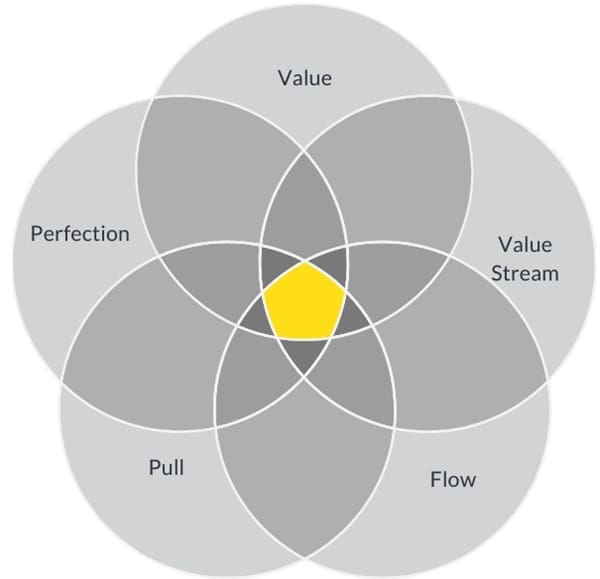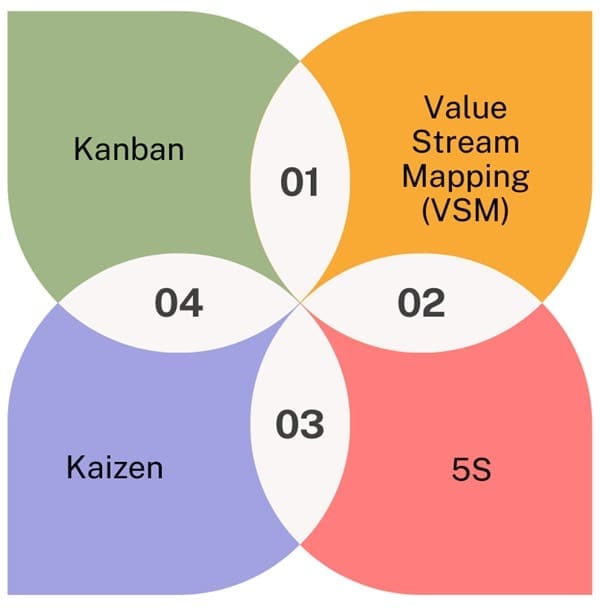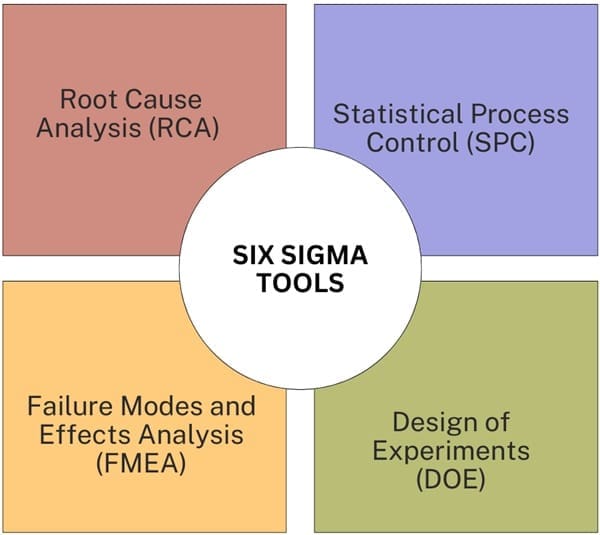Businesses widely recognize Lean and Six Sigma as key methodologies for process management. They play a significant role in driving improvement. Both aim to enhance efficiency and effectiveness within organizations, but they approach this goal in different ways.
This post explains the differences between Lean and Six Sigma. It covers their methodologies, applications, and how to combine them for greater organizational success.
Table of contents
Lean
Lean is a systematic approach focused on the elimination of waste (“muda” in Japanese) and the enhancement of value from the customer’s perspective. Waste, in Lean terminology, is any activity or process that consumes resources without adding value to the end product or service.
It emphasizes the importance of understanding customer needs and aligning all activities to meet those needs as efficiently as possible.
Lean principles are often summarized by the following key concepts:

- Value: Identify what the customer perceives as value and focus on activities that contribute directly to delivering this value.
- Value Stream: Map out the entire process flow, from raw materials to finished products, to identify and eliminate wasteful steps.
- Flow: Ensure that the production process flows smoothly without interruptions, bottlenecks, or delays.
- Pull: Produce only what is needed when it is needed, based on customer demand, rather than pushing products through the process.
- Perfection: Continuously seek to improve all aspects of the process, striving for perfection through iterative enhancements.
It emphasizes the philosophy of continuous improvement (Kaizen). It encourages employees at all levels to identify inefficiencies and suggest improvements. The ultimate goal of Lean is to create more value for customers with fewer resources, thereby increasing overall efficiency and competitiveness.
Six Sigma
Six Sigma is a data-driven methodology aimed at improving the quality of processes by identifying and eliminating the causes of defects and minimizing variability.
The name “Six Sigma” refers to the statistical concept of achieving a defect rate of no more than 3.4 defects per million opportunities, which corresponds to six standard deviations between the mean and the nearest specification limit.
Six Sigma is built around the DMAIC framework, which stands for:
- Define: Clearly define the problem, the project goals, and customer requirements.
- Measure: Collect and analyze data to measure the current performance of the process.
- Analyze: Identify the root causes of defects or variations in the process.
- Improve: Develop and implement solutions to address the root causes and improve the process.
- Control: Monitor the process to ensure that improvements are sustained over time.
Six Sigma relies heavily on statistical tools and techniques to identify patterns, measure performance, and assess the effectiveness of improvements. Some of the commonly used tools in Six Sigma include Statistical Process Control (SPC), Design of Experiments (DOE), and Failure Modes and Effects Analysis (FMEA).
The goal of Six Sigma is to reduce variability in processes, leading to consistent, high-quality outputs that meet or exceed customer expectations.
Historical Background
Lean
Lean has roots in the early 20th century. Toyota in Japan notably developed and refined its principles. The Lean methodology evolved from the Toyota Production System (TPS). Taiichi Ohno, Shigeo Shingo, and other engineers at Toyota developed TPS during the 1940s and 1950s.
The Toyota Production System addressed the need for efficiency and flexibility in post-war Japan. It emerged in a time of scarce resources and highly variable market demand.
Toyota’s approach was revolutionary in that it shifted the focus from mass production (which was the norm in Western manufacturing) to a system that emphasized the elimination of waste and continuous improvement.
Some of the key concepts developed within the TPS include:
- Just-In-Time (JIT) Production: Align production with customer demand by producing only what is needed. Produce items when required and in the exact quantity needed to reduce inventory costs and minimize waste.
- Kaizen: Encourage all employees, from top management to shop floor workers, to contribute ideas for process improvements. Apply a philosophy of continuous improvement to enhance operations.
- Jidoka (Autonomation): Empower machines and workers to stop production when they detect a defect. Prevent defective products from advancing further along the production line.
The success of the Toyota Production System led to widespread recognition of Lean principles, particularly after the publication of the book “The Machine That Changed the World” by James P. Womack, Daniel T. Jones, and Daniel Roos in 1990.
This book popularized the term “Lean” and introduced the Western world to the efficiency and effectiveness of Lean manufacturing practices.
Today, Lean principles have been adapted and applied across various industries beyond manufacturing, including healthcare, services, and even software development. The focus on waste reduction, customer value, and continuous improvement has made Lean a versatile and powerful methodology for organizations seeking to enhance their operational performance.
Six Sigma
Six Sigma was developed in the 1980s by Motorola as a means to improve the quality of their products and processes. At the time, Motorola was facing intense competition from Japanese manufacturers, who were producing higher-quality products at lower costs.
In response, Motorola’s leadership, including Bill Smith and Mikel Harry, began to explore ways to reduce defects and improve process consistency.
Bill Smith, an engineer at Motorola, formalized the Six Sigma methodology. People often credit him as the “father” of Six Sigma. He built the approach on measuring and analyzing process data to identify root causes of defects and take corrective actions to eliminate them.
The goal was to achieve a level of quality that would result in no more than 3.4 defects per million opportunities.
Motorola’s adoption of Six Sigma led to significant improvements in product quality and cost savings, and the company won the Malcolm Baldrige National Quality Award in 1988 in recognition of its achievements. The success of Six Sigma at Motorola caught the attention of other companies, most notably General Electric (GE).
Under the leadership of Jack Welch, GE adopted Six Sigma in the mid-1990s and made it a central part of the company’s strategy. Welch championed the methodology, and GE invested heavily in training its employees in Six Sigma principles and tools. The results were impressive, with GE reporting billions of dollars in savings and quality improvements.
The widespread success of Six Sigma at GE led to its adoption by numerous other companies across various industries, making it one of the most popular and widely recognized quality improvement methodologies in the world.
Manufacturers, healthcare providers, and finance professionals use Six Sigma to drive process improvements. Many other sectors also apply it to achieve high levels of quality and efficiency.
Key Differences Between Lean and Six Sigma
While Lean and Six Sigma share common goals of improving processes and enhancing efficiency, they differ significantly in their focus, approach, and tools. Understanding these differences is crucial for organizations looking to implement one or both methodologies effectively.
Focus
The primary focus of Lean is on the elimination of waste and the improvement of process flow. Lean seeks to identify and remove any activities or steps in a process that do not add value from the customer’s perspective.
This can include reducing unnecessary movement, excess inventory, waiting times, and overproduction. The goal is to create a streamlined process that delivers value to the customer as efficiently as possible.
In contrast, Six Sigma is focused on reducing variation and defects in processes. While Lean is concerned with efficiency, Six Sigma is concerned with quality.
Six Sigma uses statistical tools to analyze process data, identify sources of variability, and implement solutions to reduce or eliminate defects. The goal is to achieve consistent, high-quality outputs that meet or exceed customer expectations.
Approach
Lean takes a qualitative, process-oriented approach to improvement. It relies on tools such as Value Stream Mapping (VSM), 5S (Sort, Set in order, Shine, Standardize, Sustain), and Kaizen events to identify waste and optimize processes. Lean emphasizes the importance of engaging employees at all levels in the continuous improvement process and encourages a culture of problem-solving and innovation.
Six Sigma, on the other hand, takes a quantitative, data-driven approach to improvement. It relies heavily on statistical analysis to understand process performance and identify root causes of defects.
Six Sigma practitioners use tools such as Statistical Process Control (SPC), Design of Experiments (DOE), and Failure Modes and Effects Analysis (FMEA) to measure, analyze, and improve processes.
The DMAIC framework provides a structured approach to problem-solving, ensuring that improvements are based on data and evidence rather than intuition or guesswork.
Goals
The goal of Lean is to improve process efficiency by eliminating waste and ensuring that resources are used in the most effective way possible. Lean aims to create a smooth, uninterrupted flow of work that delivers value to the customer with minimal waste. The focus is on reducing lead times, increasing flexibility, and enhancing overall productivity.
The goal of Six Sigma is to improve process quality by reducing variability and defects. Six Sigma aims to achieve near-perfect quality, with a defect rate of no more than 3.4 defects per million opportunities.
By reducing variation in processes, Six Sigma ensures that outputs are consistent and meet the highest standards of quality. The focus is on delivering products and services that are free of defects and that consistently meet customer expectations.
Tools and Techniques
Lean uses a variety of tools and techniques to identify and eliminate waste. Some of the most commonly used Lean tools include:

- Value Stream Mapping (VSM): A visual tool used to map out the flow of materials and information in a process. VSM helps identify wasteful activities and areas for improvement.
- 5S: A workplace organization method that involves sorting, setting in order, shining, standardizing, and sustaining the work environment. 5S aims to create a clean, organized, and efficient workspace.
- Kaizen: A philosophy of continuous improvement that encourages all employees to identify and suggest improvements to processes.
- Kanban: A visual scheduling system that helps manage work in progress and ensure that production is aligned with customer demand.
Six Sigma relies on statistical tools and techniques to measure, analyze, and improve processes. Some of the most commonly used Six Sigma tools include:

- Statistical Process Control (SPC): A method of monitoring and controlling processes using statistical charts to detect and prevent defects.
- Design of Experiments (DOE): A systematic approach to testing and analyzing the effects of multiple variables on a process.
- Failure Modes and Effects Analysis (FMEA): A proactive tool used to identify potential failure points in a process and assess their impact on quality.
- Root Cause Analysis (RCA): A method of identifying the underlying causes of defects or problems in a process.
Implementation
Lean implementation often begins with a focus on specific areas of the organization where waste is most prevalent. Lean projects typically have a short duration and implement improvements incrementally. Teams make continuous improvements throughout the project.
The approach encourages employees at all levels to identify waste. Employees also suggest improvements as part of the process.
Six Sigma implementation is more structured and formal, often requiring the involvement of specially trained professionals known as Black Belts and Green Belts. Six Sigma projects are typically larger in scope and duration, with a focus on addressing complex, high-impact problems.
The DMAIC framework provides a step-by-step approach to problem-solving, ensuring that improvements are based on data and rigorous analysis.
Integration of Lean and Six Sigma
Lean and Six Sigma can be implemented independently. Many organizations integrate the two methodologies to create a more comprehensive approach to process improvement. The combination of Lean and Six Sigma, often referred to as Lean Six Sigma, leverages the strengths of both methodologies to achieve greater results.
Lean Six Sigma
Lean Six Sigma combines the waste-reduction focus of Lean with the quality-improvement focus of Six Sigma. By integrating the two approaches, organizations can address both efficiency and quality simultaneously. Lean tools streamline processes and eliminate waste. Six Sigma tools reduce variability and improve quality.
The integration of Lean and Six Sigma provides a powerful framework for achieving operational excellence. Lean Six Sigma projects typically follow the DMAIC framework but incorporate Lean tools and principles at each stage of the process. This allows organizations to not only reduce defects and improve quality but also to do so most efficiently and cost-effectively possible.
Case Studies
Let’s examine two case studies that successfully applied Lean and Six Sigma. These will illustrate the effectiveness of both methodologies.
Case Study 1: Toyota – Lean Implementation
Toyota is often cited as the gold standard for Lean implementation. The company’s adoption of Lean principles, through the Toyota Production System (TPS), revolutionized the automotive industry and set the benchmark for manufacturing excellence.
In the 1950s, Toyota faced significant challenges, including limited resources and intense competition from Western automakers. To overcome these challenges, Toyota engineers developed a production system that emphasized waste reduction, continuous improvement, and respect for people.
One of the key innovations of TPS was the introduction of Just-In-Time (JIT) production. JIT allowed Toyota to produce only what was needed when it was needed, minimizing inventory costs and reducing waste. The company also implemented Kaizen, encouraging all employees to participate in continuous improvement efforts.
As a result of these Lean practices, Toyota was able to achieve significant cost savings, improve product quality, and increase production efficiency. Toyota stands as one of the most profitable and respected automotive manufacturers in the world. Companies across various industries have adopted its Lean principles.
Case Study 2: General Electric (GE) – Six Sigma Implementation
General Electric (GE) is one of the most well-known examples of successful Six Sigma implementation. Under the leadership of Jack Welch, GE adopted Six Sigma in the mid-1990s as a central part of the company’s strategy to improve quality and reduce costs.
GE invested heavily in Six Sigma training, with thousands of employees becoming certified as Black Belts and Green Belts. The company implemented Six Sigma across all its business units, from manufacturing to finance to customer service.
One of the key successes of Six Sigma at GE was the reduction of defects in the company’s aircraft engine manufacturing process. By applying the DMAIC framework and using statistical tools to analyze process data, GE was able to identify the root causes of defects and implement solutions to eliminate them. This led to significant improvements in product quality and a reduction in warranty costs.
The success of Six Sigma at GE resulted in billions of dollars in savings and established the company as a leader in quality and operational excellence. GE’s experience with Six Sigma also inspired other companies to adopt the methodology, leading to its widespread use in various industries.
Lean Vs Six Sigma
| Basis | Lean | Six Sigma |
| Focus | Eliminating waste and improving process flow | Reducing variability and defects in processes |
| Primary Goal | Efficiency and speed | Quality improvement and defect reduction |
| Approach | Continuous, incremental improvements (Kaizen) | Structured, data-driven problem-solving (DMAIC) |
| Key Principles | Value stream mapping, 5S, Kaizen, Just-In-Time (JIT) | Statistical analysis, process control, root cause analysis |
| Tools | Value Stream Mapping, 5S, Kanban, Kaizen | Statistical Process Control (SPC), Design of Experiments (DOE), Failure Modes and Effects Analysis (FMEA) |
| Implementation | Bottom-up, with employee involvement at all levels | Top-down, often led by specialized roles (Black Belts, Green Belts) |
| Project Scope | Smaller, incremental improvements | Larger, more complex projects |
| Timeframe | Short-term, continuous improvement cycles | Longer-term, project-based improvements |
| Training Requirements | Less formal training; focus on employee engagement | Formal training and certification (e.g., Green Belt, Black Belt) |
Final Words
Lean and Six Sigma are two powerful methodologies that have transformed the way organizations approach process improvement and quality management. While they have distinct focuses and approaches, both methodologies share the common goal of delivering value to customers by improving efficiency, reducing waste, and enhancing quality.
Lean emphasizes the importance of eliminating waste and creating a smooth, efficient flow of work, while Six Sigma focuses on reducing variability and defects to achieve high levels of quality. By understanding the key differences between these methodologies, organizations can make informed decisions about which approach best suits their needs.

About Six Sigma Development Solutions, Inc.
Six Sigma Development Solutions, Inc. offers onsite, public, and virtual Lean Six Sigma certification training. We are an Accredited Training Organization by the IASSC (International Association of Six Sigma Certification). We offer Lean Six Sigma Green Belt, Black Belt, and Yellow Belt, as well as LEAN certifications.
Book a Call and Let us know how we can help meet your training needs.



















